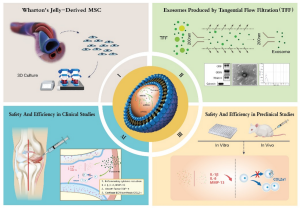BMC Musculoskelet Disord, 26/04/2025
Introduction
Osteoarthritis (OA) is a common degenerative joint disease characterized by cartilage degradation and subchondral bone abnormalities, leading to reduced quality of life. OA affects approximately 528 million people worldwide, primarily individuals over 55 years old and women, with the knee being the most commonly affected joint. Obesity and metabolic disorders such as diabetes, dyslipidemia, and hypertension are important risk factors.
Current treatments, including medications, intra-articular injections (corticosteroids, hyaluronic acid [HA], platelet-rich plasma [PRP]), and surgery, mainly provide symptomatic relief, have short-term effects, and carry various limitations and risks. Therefore, cell-based therapies, particularly mesenchymal stem cells (MSCs), have gained attention due to their self-renewal, differentiation, and immunomodulatory properties. Among them, MSCs derived from human placenta (hP-MSCs) stand out for their high proliferative capacity and minimal ethical concerns.
Clinical trials investigating hP-MSCs for knee osteoarthritis remain limited, and standardized parameters regarding dosage, number of injections, and outcome measures have not been established. This study aims to evaluate the efficacy of three intra-articular injections of cryopreserved hP-MSCs combined with hyaluronic acid (HA) in the treatment of knee osteoarthritis.
Methods
Study Subjects and Design
A total of 32 patients (11 men, 21 women; aged 23–78 years) were initially enrolled, of whom 6 were excluded for not meeting the selection criteria.
- Inclusion criteria included: confirmed diagnosis of knee osteoarthritis (OA) stage II–III according to the Kellgren & Lawrence classification based on X-ray imaging; chronic joint pain lasting ≥ 3 months; age 18–75 years.
- Exclusion criteria included: systemic or local infection, use of corticosteroids or anticoagulants, history of cancer or organ transplantation, stroke, myocardial infarction, liver or kidney failure, or age outside the range of 18–75 years.
All patients provided written informed consent to participate in the study.
Finally, 26 patients (9 men, 17 women; aged 23–74 years) were divided into two groups:
- Control group: 11 patients received three intra-articular injections of hyaluronic acid (HA, Hyalgan® 20 mg/2 mL) at 4-week intervals.
- MSC group: 15 patients received the same HA treatment combined with three intra-articular injections of human placenta-derived mesenchymal stem cells (hP-MSCs).
There were no statistically significant differences between the two groups in terms of age, sex, BMI, or severity of osteoarthritis (P > 0.05).
hP-MSCs preparation
Placental tissue was obtained after cesarean section from 9 healthy donors (aged 23–36 years, full-term pregnancies of 39–41 weeks) at Kyiv City Maternity Hospital No. 3, with written informed consent and infectious disease screening performed one week prior to collection. The placental tissue was minced, washed with antibiotics, and digested with collagenase I and dispase I, then cultured in α-MEM supplemented with 15% FBS for 14 days. When cells reached 80–90% confluence, they were passaged up to passage 3 and cryopreserved in HBSS containing 5% DMSO at a concentration of 5×10⁶ cells/mL. Each cell batch underwent quality control for viability, surface marker identification, differentiation potential, karyotype, and microbiological testing; only batches meeting all criteria were used in the study.
hP-MSCs transplantation
Human placental mesenchymal stem cells (hP-MSCs) at passage 3 were thawed, centrifuged, and resuspended in 0.9% NaCl containing 5% human serum albumin (HSA), with an average viability of 85.4 ± 4.3%. Each injection dose consisted of 20 million cells mixed with 2 mL of Hyalgan® (20 mg HA) and was administered into the knee joint via the anterolateral approach with the knee flexed at 90°. The total dose over three injections was 60 million cells. The procedure was performed under aseptic conditions, with monitoring for local and systemic reactions following injection.
Follow-up
Clinical outcomes were assessed at 6 and 12 months after the first injection in 24 out of 26 patients who completed follow-up. The WOMAC and VAS scales were used to evaluate pain, joint stiffness, and functional limitation, combined with clinical orthopedic examination and contrast-enhanced knee MRI to assess cartilage. Serum cytokine levels (IL-2, IL-10, IP-10, MIP-1α, TNF-α, MCP-1) were measured by ELISA. The frequency and nature of adverse events (AEs) were also monitored to determine their relationship with hP-MSC injections.
Indices determination
We used the WOMAC questionnaire as a standardized tool to assess symptoms of knee and hip osteoarthritis. The questionnaire includes items related to pain, stiffness, and physical, emotional, and social function, with each question scored on a scale from 0 to 4 points.
VAS was used as a validated, subjective measure for acute and chronic pain. Patients marked their pain level on a 10-cm line, which represents a continuum from “no pain” to “worst pain” [22]. WOMAC and VAS were assessed at baseline (before treatment), and again at 6 and 12 months after the administration of HA and hP-MSCs.
Body mass index was calculated by dividing body weight (kg) by height squared (m2).
MRI examination
Knee MRI assessments were performed at baseline, 6 months, and 12 months. The following indices were assessed: cartilage thickness and optical density of cartilage tissue. Cartilage thickness was measured at 15 points: Patella– P1, P2, P3; Tibia Lateral– TL1, TL2, TL3; Tibia Medial– TM1, TM2, TM3; Femur Lateral– FL1, FL2, FL3; and Femur Medial– FM1, FM2, FM3. Additionally, the difference (delta of increase) between the 6 and 12-months measurements and the baseline values was calculated for each patient to adjust individual characteristics. The optical density of the cartilage tissue was measured in 3D WATS post-contrast in the P, TL, TM, FL, and FM areas, and the soft tissue proportionally related to cartilage hydrophilicity. To standardize measurements across different device settings, the optical density index was calculated in each area (P/S, etc.) relative to the optical density of soft tissues (S).
Blood collection
- Samples: 12–20 mL of peripheral blood was collected from 26 KOA patients at hospital admission (baseline) and at 6 months.
- Basic hematology tests
- Sample storage
- Biochemical tests
- Immunological tests
Cytokine measurement
Serum levels of IL-2, IP-10, MIP-1α, IL-10, TNF-α, and MCP-1 were measured. This method allows accurate evaluation of changes in pro-inflammatory and immunoregulatory cytokines associated with hP-MSC therapy.
Statistical Analysis
This method ensures that results are evaluated accurately and transparently across groups and over time.
Results
- Adverse Events (AEs)
- MSC group: After the first dose, 73% of patients reported joint pain and 26.7% experienced swelling; in the Control group, only 12.5% reported discomfort.
- After the second and third doses, the incidence of pain, swelling, synovitis, and restricted movement increased significantly in the MSC group compared to the Control group.
- All AEs resolved spontaneously within 3–7 days, with no serious adverse events observed after 2 weeks.
- Clinical Scores
- MSC group: WOMAC and VAS scores decreased significantly at 6 months and 1 year compared to baseline.
- Control group: Scores did not change significantly over 1 year.
- Between-group comparison: No significant differences in WOMAC scores were observed at 6 months and 1 year.
- MRI
- Cartilage thickness measurements at different points showed no significant differences between the two groups after 1 year.
- Blood Tests:
- After 6 months, the Control group showed an increase in total and segmented neutrophil counts, whereas no changes were observed in the MSC group.
- Other hematological and biochemical parameters remained unchanged.
- Serum Cytokines
- TNF-α, IP-10, MIP-1α, MCP-1, and IL-10 showed no differences between groups or over the 6-month period.
- IL-2: The MSC group showed a significant decrease after 6 months, with a larger reduction than in the Control group.
Discussion
Objectives and Novelty
- This study compared three injections of hP-MSCs combined with HA versus HA alone in symptomatic KOA patients.
- It is the first study to evaluate the effects of three consecutive hP-MSC injections on KOA, whereas previous studies only reported two or four injections of hUC-MSCs or adipose-derived MSCs.
Quality Criteria for hP-MSCs
- No bacterial, fungal, or mycoplasma contamination; normal karyotype; expression of CD73, CD90, CD105 ≥95%, and CD45, CD34 ≤2% according to ISCT standards.
- MSCs from fetal and placental sources are preferred due to the absence of ethical restrictions, ease of collection, preservation of high proliferative potential, and inherent immunomodulatory capacity.
Safety
- AEs were mainly transient pain, swelling, and limited mobility, resolving within 1 week; no SAEs were observed.
- Similarly, previous studies using hUC-MSCs or adipose-derived MSCs reported mild and transient AEs.
Clinical Efficacy
- WOMAC and VAS scores improved at 6 and 12 months but did not show significant differences compared to the HA group.
- The hP-MSC dose was based on previous studies, with a total of 60 million cells over three injections.
MRI
- No significant changes in cartilage thickness were observed between the two groups after 1 year.
- MRI outcomes depend on dosage, injection frequency, and baseline patient characteristics; one year may be too short to detect structural changes.
Cytokines and Inflammatory Response
- Serum IL-2 decreased significantly in the MSC group, reflecting a systemic anti-inflammatory effect.
- No changes were observed in TNF-α, IL-10, IP-10, MIP-1α, or MCP-1.
- These cytokines are associated with joint inflammation and KOA progression.
Clinical Implications and Future Research
- hP-MSC therapy is safe and improves clinical symptoms in patients with stage II–III KOA.
- Larger-scale clinical trials with control groups are needed to determine optimal dosage and injection frequency.
Conclusion
Multiple intra-articular injections of allogeneic human placenta-derived MSCs combined with hyaluronic acid are safe for treating knee osteoarthritis and appear to be effective at the 1-year follow-up. An advanced, dose-dependent, placebo-controlled, double-blinded clinical trial is needed to determine the efficacy of administering human placenta-derived MSCs to patients with knee osteoarthritis.
References
Source: Holiuk, Y., Birsa, R., Bukreieva, T. et al (2025). Effectiveness and safety of multiple injections of human placenta-derived MSCs for knee osteoarthritis: a nonrandomized phase I trial. BMC Musculoskelet Disord 26, 418.
Link: https://bmcmusculoskeletdisord.biomedcentral.com/articles/10.1186/s12891-025-08664-2#citeas








